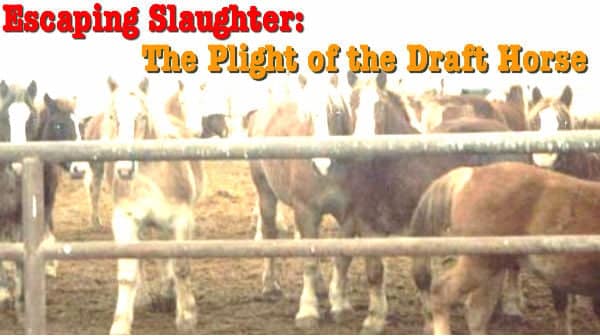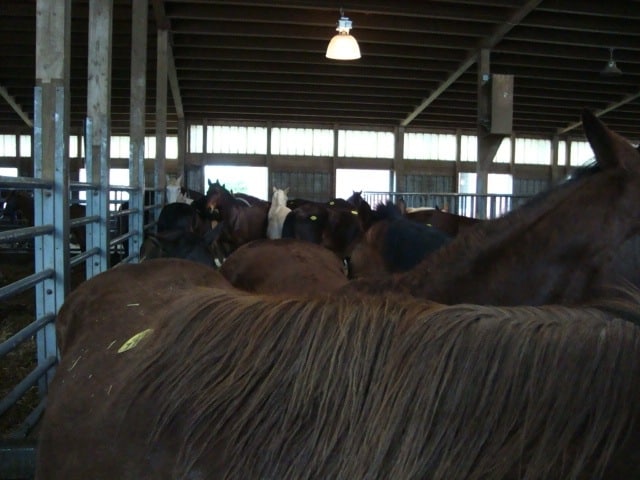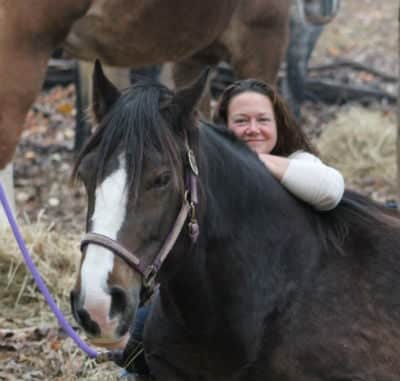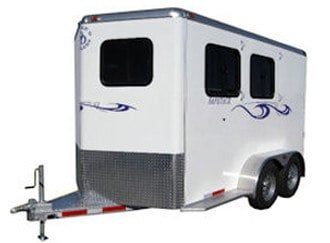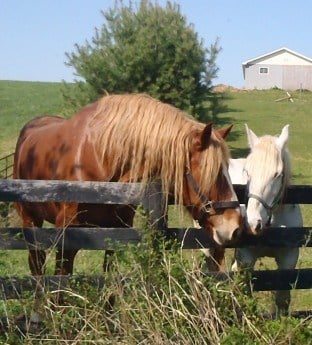Escaping Slaughter – The Plight of the Draft Horse
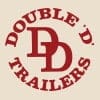
Hundreds of thousands of horses have been slaughtered in the United States in the last few decades until the practice was mostly ended on September 21, 2007. According to Christine, The practice ended "over wording in a congressional USDA Appropriations bill that prohibited federal funding to be used for USDA inspectors to inspect horse carcasses." With the passing of this legislation, the problem was shifted to our neighboring countries. Today, horses are shipped to Canada and Mexico for slaughter where their meat is sold to countries like Japan that consider horse meat a delicacy. In 2014, 40,936 horses were sent to Canada and 105,406 horses were sent to Mexico for slaughter.
These horses often endure long cramped rides in horse trailers and inhumane treatment once they reach their destination. (Note: This linked video is not overly graphic, but it is still hard to watch.) Legislation called the Safeguard American Foods Exports Act of 2013 sits on Capital Hill to end this export, but is unlikely to ever come to a vote. Christine shared even worse news regarding the original legislation that ended most US horse slaughter, "The verbiage in this spending bill looks like it will be removed again, which could open US slaughter back up."
Why Are Draft Horses Slaughtered?
We spoke with Christine about the specific risk facing draft horses when they are sent to auction. “Draft horses, pound for pound, are fleshier and more lucrative for sale at slaughter,” she explained. “Literally, you get more ‘bang for your buck.’”
Another reason draft horses are especially at risk is the high concentration of Amish populations within easy transport of Canada where slaughter occurs. “Since many of their communities are clustered in the Northeast coast and in Ohio, most of their cast-off or spent work horses are funneled into New Holland (PA) and Sugar Creek (OH) auctions, which are direct pipelines to slaughter.”
When the staff of Gentle Giants attends these auctions, they look for the horses that are most at risk of being purchased by meat buyers. Exported horse meat brings $14 to $18 a pound, so the bids from meat buyers can be pretty high for draft horses who can easily be fattened up for profit. They are not able to save all of the horses and any horse given a yellow USDA export tag is beyond help.
New Holland auction kill pens. The yellow USDA export tag means these horses have had their fates sealed. They cannot be saved.
It seems incredible that our nation allows this slaughter to take place. There is current legislation called the Safe America Foods Export Act of 2014 that is currently waiting to be voted upon. This act states that it should be illegal to slaughter horses on US soil or export horses for the purposes of human consumption because the meat is unsafe. Veterinary and medical care during the horse’s life introduced chemicals that wouldn’t normally be allowed in animals bound for human consumption. Christine lamented, “As of yet, the bill has not come for a vote, and likely never will.”
The Road to a Kill Pen
Most of the rescued slaughter-bound draft horses that come into the Gentle Giants horse rescue are former Amish workhorses that were used to plow the fields. They also receive some show horses, carriage horses, and draft crosses coming from PMU and the Nurse Mare industries.
The PMU industry is where mares are continually bred in extreme confinement so that the hormones from their urine can be collected for drug manufacturing. The spent mares and resultant foals often end up going to slaughter. The nurse mare program is where mares are bred so that they begin milk production to nurse the foals of more highly prized mares like Thoroughbred racehorses. Again, the resultant foals often have a doomed fate. Draft cross breeds from these operations show up at the Gentle Giants horse rescue.
Over breeding outside of these industries is a problem too. Christine explained, “Also culpable are ‘back yard breeders’; low end breeders who produce horses with no viable demand or plan for the offspring.”
While there are many types of draft horses at the rescue, Christine has noticed a pattern. The breeds coming from the Amish farms are typically the less flashy Belgians and Percherons. “Tenets of the Amish religion call for a life of plainness and a shunning of all things considered to be proud or showing off, therefore the Amish rarely use the flashier breeds such as Clydesdales, Shires, or Spotted Drafts.”
A New Life After Plowing the Fields
We are certainly not condemning the use of draft horses for agriculture. It is only unfortunate that the retired workhorses cannot be given a better life after plowing the fields. Draft horses are highly intelligent animas, relatively calm, enjoy a cooperative working relationship with humans, and have a strong will to please.
Christine explained that they make ideal riding horses and companions. “In general, they are more gentle, level headed, and cooperative than breeds of horses that have been selectively bred for athletic performance.”
Christine Hajek works at the Gentle Giants Draft Horse Rescue in Mt. Airy, MD.
You would think that carriage work would be a natural transition for a former plow horse. In fact, draft horses that have escaped slaughter cannot always adapt immediately to pulling carriages. “Field horses are taught to pull strong and hard and to not stop… and that is not a good combination when you add wheels to the equation!”
For this reason, the folks at the Gentle Giant Draft Horse Rescue apply a complete retraining program for every horse. They are given new roles as riding horses and Christine beamed that they all adore their new jobs. “They seem to find the ease of their new work to be a gift, and they enjoy getting out and doing different things,” she explained. “Drafts tend to make amazing trail horses, especially for the less experienced rider.”
Owners of exceptionally large horse breeds sometimes have trouble finding the right size trailer. All of the custom horse trailers from Double D Trailers can be designed to fit your exact needs.
Christine shared these five reasons why you should consider adopting a rescued draft horse (or any rescued horse for that matter!)
- No guesswork, and no “buyer beware.” When you adopt from a reputable rescue, you are getting a horse that has been fully vetted, head to toe; and any known illnesses or lameness should be fully disclosed.
- Good pairing. You are getting a horse from a charity that has a vested interest in pairing you with the right horse for long-term success, rather than someone just trying to sell their horse to anyone who will pay.
- Up-to-date medical care. A reputable rescue not only thoroughly evaluates their horses’ abilities and temperaments, but also has them current on all medical needs, vaccines, farrier care, and dental care.
- No getting stuck with a horse you don’t want. If for any reason your horse doesn’t work out or your life changes, a reputable rescue will take the horse back, no questions asked.
- When you adopt, you make room for a new horse to be saved!
The draft horses from the Gentle Giants Draft Horse Rescue are given a new chance at life as riding companions.
Christine’s shared her top experience of working with draft horses. “My favorite thing? When people look up with their jaws open and whisper “WOWWW” as I ride past.” These animals may not be fancy sport horses, but they certainly have a lot to offer to the equestrian community.
Christine summed up the issue nicely:
“We have over 9 million horses in the United States. So when we look at that number as a whole, the number of horse that are being exported for slaughter every year is only 1%. If we could get our horse breeders to breed 1% less, if we could get our horse owners to be 1% more responsible, if we could get 1% of people to choose to euthanize their old horse instead of sending it off to auction for $200, then we could completely solve this problem. The reality is this is something we can actually change.”
It is important to recognize the specific threat draft horses are under from horse slaughter. To learn more about the rescue, visit their website. Also, check out this site to learn how you can contact your local congressman to gain support for legislation to stop the practice of exporting horses form the US for slaughter. Perhaps, when you buy your next trail horse, you’ll consider a draft horse from the Gentle Giants Draft Horse Rescue.
Questions:
What are your experiences working with draft horses?
What are your opinions on the exportation of horses for slaughter from the United States?

